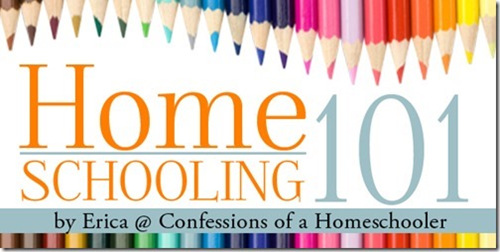Good morning! Today I have another Homeschooling 101 post to add to my series. Today we’re talking about homeschooling special needs students.
First off I want to encourage you that you are not alone!
There are several families that have chosen to homeschool children with special needs. The needs may range from something such as attention deficit disorder to children with more severe and multiple handicaps.
Often bringing special needs children home to be educated is a wonderful way to reach an otherwise reluctant student. As their parent you can offer your student the security, stability, flexibility, and encouragement they need to be successful.
While I do not personally have special needs students there are a wide variety of websites and information available to homeschooling your students.
One thing I’ve learned about this topic is that each student’s needs are unique, and so your approach to homeschooling them will also have to be individualized towards your specific student. The blessing with homeschooling is that you can easily do that, though it might take a little more research, along with some trial and error to find what works best for your family.
For preschool and Kindergarten I’ve been told that my curriculum is great for special needs students because it is colorful, and very hands-on. You can take a look at those here:
My Letter of the Week preschool curriculum is a full 26 week preschool course designed to give your student a head-start on preparing for kindergarten. I normally recommend this for 3-4 year olds, but can also be used with older special needs students. It focuses on the letter recognition, sounds, number recognition, counting, basic math skills, pre-writing practice, and all the necessary fine-motor skills that will be required for your student get ready for kindergarten! Included are weekly lesson plans that cover all the subjects your student needs.
The K4 Curriculum is great for kids who are ready to start Kindergarten. The curriculum introduces beginning reading, math and handwriting skills that will give your student a huge advantage as they proceed through their elementary years.
Upon completion of this program, students will have a basic understanding of simple addition and subtraction, place value, basic 1 and 2 vowel words, and beginning reading skills, logical thinking and much more! With this curriculum you also receive 34 weeks worth of daily lesson plans to help guide you through a full year kindergarten skilled activities.
For older students, here is a list of some amazing websites to help get you started:
- Autism Speaks: www.autismspeaks.org
- Dianne Craft: www.diannecraft.org
- Family Education: www.school.familyeducation.com – Homeschooling your special needs child
- Handwriting Without Tears: www.hwtears.com – Program developed by an occupational therapist and handwriting specialist
- HSLDA: www.hslda.org
- Laureate Special Needs Software: www.laureatelearning.com – Offers a variety of programs for language acquisition.
- NATHHAN: www.nathhan.com – National Challenged Homeschools Associated network
- NHEN: www.nhen.org – Library of Special Needs Articles
- NorCal Center on Deafness, Inc: www.norcalcenter.org – Offers workshops, social events, and a summer camp for the deaf and hard of hearing
- PACE: www.tckconsultant.org – Special Needs Education
- Sensory Processing Disorder Foundation: www.spdfoundation.net
- Legal Resources for Special Needs
- Keeping Disabled Persons Safe While Remodeling
- Creating a Home Where Your Disabled Child can Thrive
- Teacher Resources for Special Needs
- Disaster Preparedness for Special Needs
- Home Accommodations for Special Needs
- Disability Resources from the Department of Labor
- Financial Planning for Special Needs
For more information on homeschooling check out my Homeschooling 101: A guide to getting started!







And don’t forget the gifted students–who are also special needs and do not fit with regular curriculum used in a traditional way just as much as students who are struggling do not fit.
Our daughter is 10 and we are homeschooling her for the first time this year. She has cerebral palsy so I know it will be a bit of a challenge but we are really hoping we can get her to learn to read. She knows all her letters and sounds but is not reading yet. I will certainly look into these resources.
Cari, I know this is a old post, but I am considering homeschooling my son who has come for the same reason. How is your daughter doing? Did she learn to read? If so, I’d love to hear what has worked for you.
I have used your programs (LOTW & K4) for both of my kids who are ‘severe’ autistic and non speaking and it is totally brilliant. Simple designs (very important to not be too busy or distracting), simple activities, and really engaging. Both of mine are very interested in ABCs so it is just perfect. Thank you!
Thankyou for posting this. There are so many special needs homeschooling families out there that get forgotten at times. Homeschooling is already challenging and even more so with a sp. needs child. I am in my 3rd year homeschooling our son who suffered a traumatic brain injury at birth and was premature. With these kiddos you just have to step back and work at their pace and forgot what everyone else is doing. We love your stuff Erica!
The biggest growing group of new homeschoolers in Australia are the Parents with Special Needs Kids. Just among those I know personally, 32 families have begun homeschooling in the last 2 years and facebook groups are filling with hundreds more.
I personally homeschool my 9 year old son who is diagnosed on the Autism Spectrum and it is fantastic. The ability to do one on one work with him, tailor work to his needs and interests, remove the distractions of a classroom and lower the anxiety has made such a huge improvement that we will never go back to mainstream schooling. We LOVE your page and your curriculum, they have proved to be a big hit with my son so a huge thank you from me to you!!!
I’m going to be homeschooling my son who has autism and ADHD next year (kindergarten). I’ve actually been copying your school room quite a bit because of the simple design. I am trying to really take advantage of our oppurtunity to customize his environment, and I think that the white theme will limit distractions the most. We ordered the same ikea chairs (do not have an ikea here) and I’m going to bracket a piece of melamine on top of 24″ tall storage cubbies to create a 4′ square table. Totally copying your workbox ideas too. I know that seeing our day in the boxes and being able to touch and interact with them (as opposed to a visual schedule, which is also good) is going to be awesome for him. Thanks for the inspiration!
I started doing the one year old preschool curriculum for my son that has a brain injury and epilepsy last month. I just found your blog today, and am so excited about the resources you’ve shared! THANK YOU!!!!